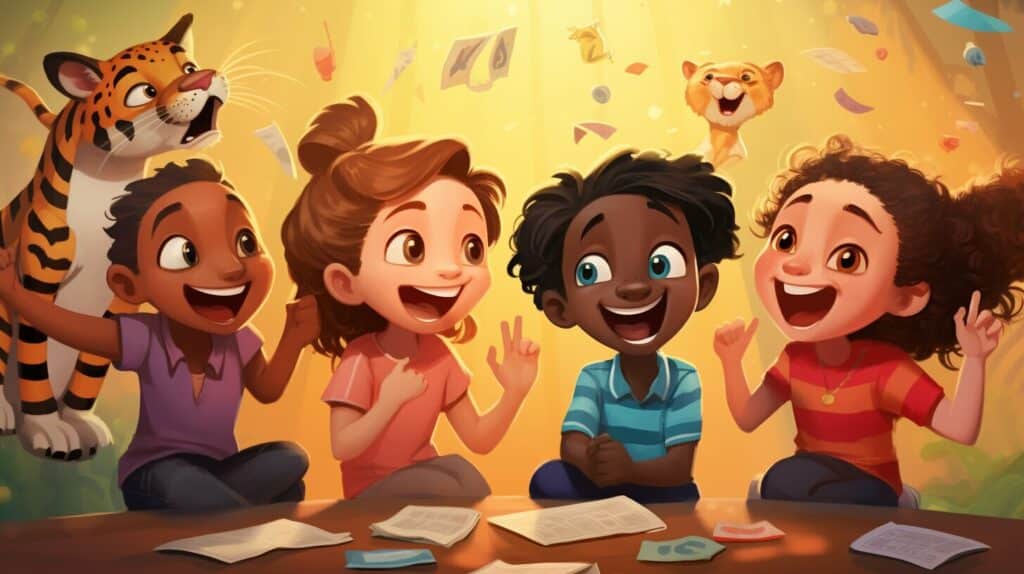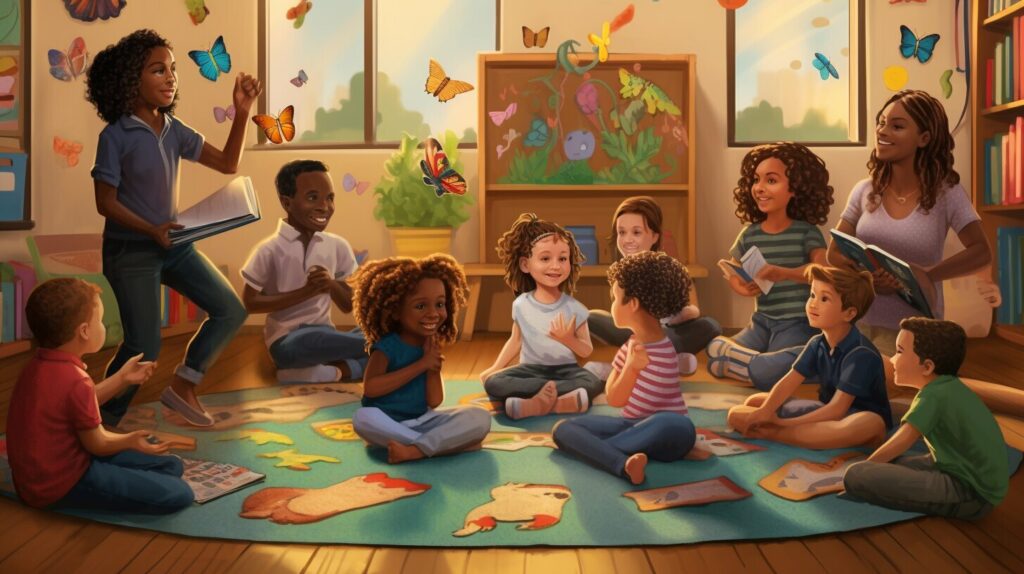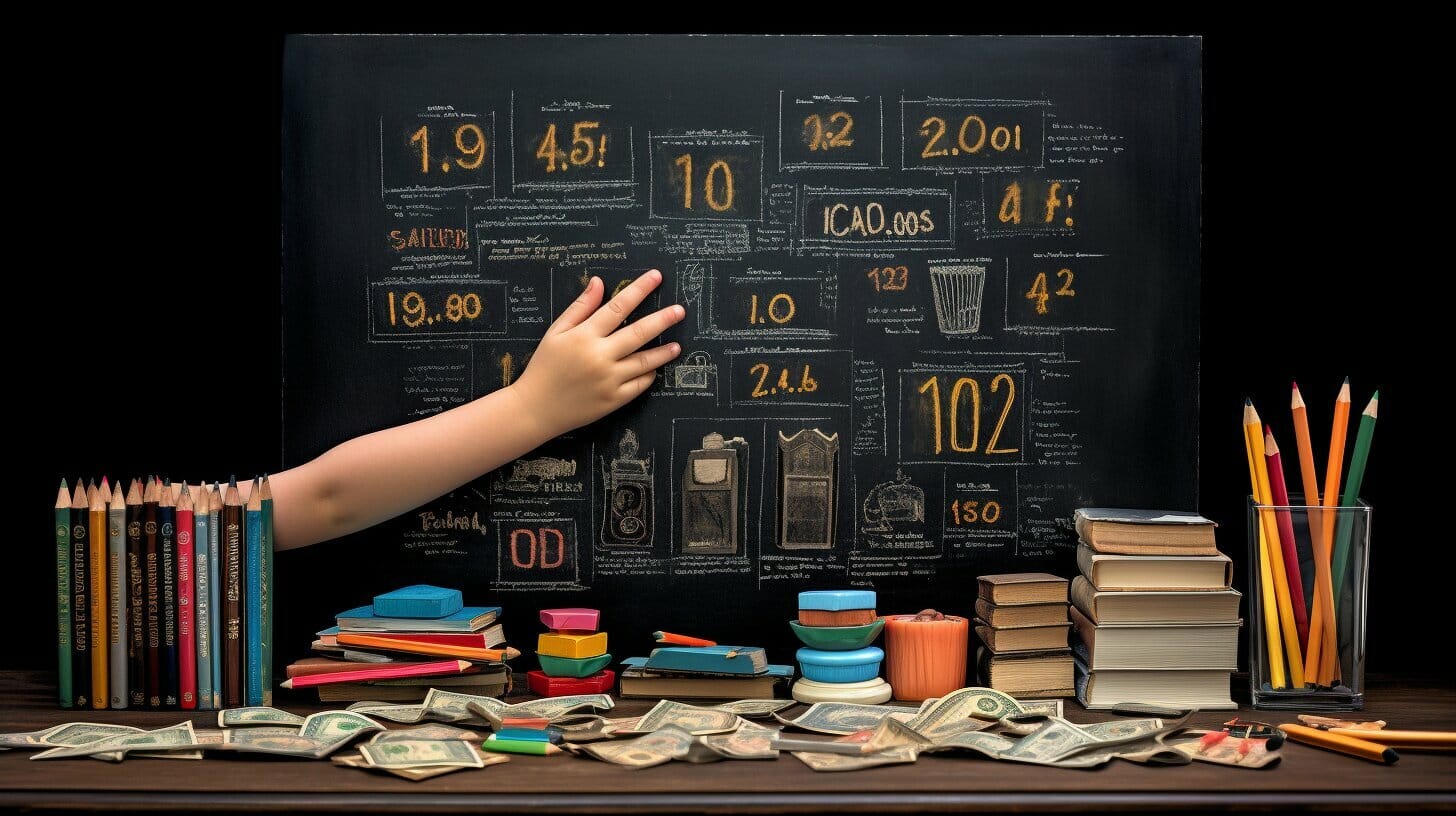Explaining literary devices to young children can be challenging, but with the right approach, it can also be fun and engaging. In this article, we will provide a step-by-step guide on how to explain simile to a child. Simile is a commonly used literary device that compares two things using the words “like” or “as”. By introducing simile to children, you can help them develop their language skills and enhance their understanding of literature.
Teaching simile to young children can seem daunting, but with the right resources and methods, it can be an enjoyable experience for both the teacher and the child. This article will provide an overview of what a simile is and explore fun and interactive ways to help children understand this literary device.
Key Takeaways:
- Simile is a literary device that compares two things using “like” or “as”.
- Introducing simile to children can help develop their language skills and understanding of literature.
- Teaching simile can be made fun and easy through the use of relatable examples and interactive activities.
- Children’s literature is a great resource for teaching simile.
- Encouraging creativity and inviting children to create their own similes can deepen their understanding of the concept.

What is a Simile?
A simile is a figure of speech that compares two things using the words “like” or “as.” It is used to make descriptions more vivid and memorable, by linking two dissimilar objects or ideas in the reader’s mind. Similes are commonly used in literature, poetry, and everyday speech, and can be fun for children to learn and use in their own writing.
Teaching Simile to Young Children
When teaching simile to young children, it is important to provide simple explanations that they can easily understand. One way to do this is to use relatable examples that children can connect with. For example, you might say:
“A simile is when you compare two things that are not the same, but have something in common. It’s like saying one thing is kind of like another thing.”
You could also provide visual aids, such as pictures or props, to help illustrate the concept of simile. For example, you could show a picture of a smiling sun and ask the child what the sun is like. They might say, “The sun is like a happy smile.” This is an example of a simile.
Simple Explanations of Simile for Kids
To further simplify the definition of simile for kids, you could use a table to compare and contrast two objects using similes. In this table, you could list two objects in the first column, and then provide a simile comparing the two objects in the second column. For example:
| Object 1 | Simile | Object 2 |
|---|---|---|
| The moon | Is like a glowing lamp in the sky | A lamp |
| A flower | Is like a colorful piece of art in nature | A painting |
By presenting similes in this way, children can see how two seemingly unrelated objects can be linked through a comparison, making the concept of simile easier to grasp.
Understanding Simile through Everyday Examples
Children learn best through relatable examples. When teaching simile to kids, it is important to use everyday examples that they can easily grasp. Here are some simile examples for children:
| Simile Example | Meaning |
|---|---|
| As sly as a fox | Describing someone who is cunning or sneaky |
| As brave as a lion | Describing someone who is courageous |
| As slow as a turtle | Describing something or someone moving at a leisurely pace |
| As sweet as sugar | Describing something or someone who is very pleasant or kind |
| As light as a feather | Describing something or someone that is very light or delicate |
Using everyday examples like these can make learning simile more enjoyable and engaging for kids. You can also encourage children to come up with their own similes based on their experiences or observations. For example, they might say:
As fast as a cheetah
Or
As quiet as a mouse
These fun ways to teach simile to kids can make the learning experience interactive and memorable. As they learn to use simile in their own conversations and writing, they will develop a greater appreciation for the power of descriptive language.

Exploring Similes in Children’s Literature
Introducing simile to children through popular children’s books can be an effective way to help them understand the concept. Not only do books provide relatable examples, but they also help children develop their comprehension skills and imagination.
Some popular children’s books that use simile include:
| Book Title | Author | Simile Example |
|---|---|---|
| Charlie and the Chocolate Factory | Roald Dahl | “The children around the table looked like Oompa-Loompas.” |
| The Cat in the Hat | Dr. Seuss | “It is fun to have fun, but you have to know how.” |
| Where the Wild Things Are | Maurice Sendak | “His room turned into a jungle.” |
After reading these books with your child, ask them to identify the similes in the story and explain what they mean. This will help reinforce their understanding of simile and teach them how to recognize it in other contexts.
Using Interactive Read-Alouds
Interactive read-alouds are an effective way to help children engage with simile in children’s literature. During an interactive read-aloud, the teacher or parent reads a book out loud and stops periodically to ask questions or engage in discussions with the child.
For example, while reading The Cat in the Hat, you could stop and ask, “What does the simile ‘It is fun to have fun, but you have to know how’ mean? Can you think of a time when you had to learn how to do something fun?” This encourages the child to think critically about the simile and apply it to their own experiences.
Interactive read-alouds can be done with any book that contains similes, making it a versatile and engaging tool for teaching simile to children.
Activities for Exploring Similes in Children’s Literature
- Ask children to draw a picture of a character in the book and write a simile to describe their appearance or behavior.
- Have children act out a scene from the book using similes in their dialogue.
- Create a visual display of the similes in the book, with illustrations or examples of each one.
By exploring similes in children’s literature through interactive read-alouds and fun activities, children can gain a deeper understanding and appreciation for this literary device.

Interactive Simile Activities for Young Learners
Learning simile can be engaging and fun with interactive activities. Here are some ideas for parents and teachers to try out with young learners:
- Simile Scavenger Hunt: Take children on a scavenger hunt around the house or outside, and challenge them to find objects that can be compared to something else using a simile. For example, “find something that is as yellow as the sun.”
- Simile Matching Game: Create index cards with one half of a simile on each card, and have children match them up with the other half. For example, the card “as strong as an ox” would match with “as fast as a cheetah.”
- Simile Charades: Write similes on slips of paper and have children act them out like charades. For example, “as quiet as a mouse” would require the child to act out being very quiet.
- Simile Storytelling: Have children create their own stories using similes. Encourage them to use descriptive language and create vivid imagery with their similes.
By incorporating interactive activities into simile learning, children can have fun while deepening their understanding of this literary device.

Creating Simile Artwork with Children
Art is a fun and creative way for children to deepen their understanding of simile. By engaging in a hands-on activity, they can express their creativity while exploring different examples of similes. Here are some simile activities for young learners:
Draw and Write Simile
Have children draw a picture of a familiar object, such as a flower or a tree. Then, ask them to write a simile describing the object. For example, “The flower is as bright as the sun.” This activity not only reinforces their understanding of simile but also encourages their writing and drawing skills.
Simile Collage
Provide children with magazines, newspapers, and other materials they can use to create a collage. Ask them to find pictures and words that represent similes, such as “as tall as a tree” or “as fast as a cheetah.” Have them cut out the pictures and words and create a collage that represents different similes.

Silly Simile Art
Encourage children to use their imagination to create silly similes. Provide them with a blank piece of paper and ask them to draw a picture of a person or an animal. Then, have them create a simile that describes the person or animal in a silly way, such as “The cat is as lazy as a couch potato.” This activity not only helps children practice creating similes but also encourages their creativity.
Incorporating Simile into Everyday Conversations
Similes can be easily incorporated into everyday conversations, making it a natural and enjoyable way to reinforce a child’s understanding of the concept. Here are some fun and simple ways to encourage young learners to use similes:
- During mealtime, encourage children to describe their food using similes. For example, “This pizza is as hot as the sun!”
- While driving or walking, point out objects and ask your child to describe them using similes. For example, “That tree looks like a big green umbrella.”
- Before bedtime, ask your child to describe how they feel using similes. For example, “I’m as tired as a bear hibernating for the winter.”
These simple conversations can help children practice and develop their use of similes in a fun and engaging way.
Simile Scavenger Hunt
A simile scavenger hunt is a great way to get children actively searching for and using similes. Create a list of similes and give it to your child, instructing them to find examples of each simile throughout their day. Examples of similes to include on the list could be:
- As busy as a bee
- As quick as lightning
- As cold as ice
- As sly as a fox
As your child finds each simile, have them write it down or draw a picture of it in a notebook. At the end of the day, review their findings with them and have them explain why they think each example is a simile.

Using similes in everyday conversation and engaging in simile-related activities can deepen a child’s understanding and appreciation of similes. As they become more comfortable with using similes, encourage children to create their own similes and continue practicing in a fun and enjoyable way.
Encouraging Children to Create Their Own Similes
Once children understand the concept of simile, it’s time to get their creativity flowing by encouraging them to create their own imaginative and descriptive similes. This not only reinforces their understanding of simile but also helps develop their writing skills.
A great way to start is by providing prompts and activities that inspire children to think outside the box. For example, you can ask them to write similes about their favorite foods, animals, or places. You can also encourage them to use their senses to create vivid and descriptive similes.
Here are some fun prompts to get started:
- Write a simile about the way a flower smells.
- Create a simile about how the wind feels on your face.
- Write a simile about the sound of a bird chirping.
Another way to encourage children to create their own similes is by incorporating simile into other activities, such as creating artwork or playing games.
A fun game you can play with children is “Simile Charades,” where they act out a simile while the others guess what it is. You can also incorporate simile into drawing activities, such as asking children to draw a picture of a simile they come up with and then share it with the group.
Overall, the key to encouraging children to create their own similes is by making it fun and engaging. By providing prompts and activities that spark their imagination, children can develop a deep understanding and appreciation for simile.

Section 9: Practicing Simile with Fun Worksheets and Games
Worksheets and games are an excellent way to reinforce a child’s understanding of simile. They can add an interactive and enjoyable element to learning and help children practice simile in a fun way. Here are some resources for fun simile-related worksheets and games:
1. Simile Worksheets
These worksheets are a great way to practice identifying similes and creating your own. They include fill-in-the-blank activities, matching games, and more. Check out these websites for free printable simile worksheets:
2. Figurative Language Games
Games are a fun and engaging way to practice simile and other types of figurative language. Check out these online games that feature similes:
3. Simile Jeopardy
Create your own game of Simile Jeopardy with kids using categories like ‘Simile Examples’, ‘Create Your Own Simile’, ‘Identify the Figures of Speech’, ‘Fill In the Blanks’, ‘Complete the Sentences’, and ‘Simile or Not’. You can find a customizable template on Super Teacher Tools.

These resources offer a variety of activities to help children practice simile in an engaging and entertaining way. By incorporating these fun games and worksheets into your teaching, you can enhance a child’s understanding of simile and make learning more enjoyable.
Further Resources for Teaching Simile to Children
Teaching simile to young children can be challenging, but with the right resources, it can be both fun and effective. Here are some additional tools and materials that can help parents and educators in their efforts to explain simile to kids:
Children’s Books
There are many children’s books that use simile in creative and engaging ways. Some popular titles include:
| Title | Author |
|---|---|
| The Cat in the Hat | Dr. Seuss |
| Where the Sidewalk Ends | Shel Silverstein |
| The Giving Tree | Shel Silverstein |
Reading these books with children can help them understand simile in a fun and creative way.
Online Tools and Resources
There are also many online resources available to assist parents and educators in teaching simile to children. Some websites that offer helpful simile-related activities and worksheets include:
These websites offer a variety of interactive activities and printable worksheets that can help children practice and reinforce their understanding of simile.
Classroom Exercises
For teachers, incorporating simile into classroom exercises can be a great way to help children apply what they’ve learned. Some fun and effective simile-related classroom exercises include:
- Having students write their own similes and sharing them with the class.
- Playing a simile matching game, where students match a simile with its corresponding meaning.
- Creating simile-inspired artwork and displaying it in the classroom.
These exercises can help children further develop their understanding and usage of simile in a hands-on, interactive way.

Conclusion
In conclusion, teaching simile to young children may seem daunting, but it can be made simple and enjoyable with the right tools and approach. By providing relatable examples, incorporating interactive activities, and fostering creativity, parents and educators can help children develop a solid understanding and love for simile.
Remember to start with a clear definition of what a simile is, and build from there with everyday examples and exploration of children’s literature. Encouraging children to create their own similes and practicing with fun worksheets and games can also reinforce their learning.
And don’t forget to incorporate simile into everyday conversations! This will help children naturally integrate simile into their own language and understanding.
For further resources, don’t hesitate to look to children’s books, online tools, and websites. With the right tools and mindset, understanding simile for kids can be a fun and enriching experience.

FAQ
How can I explain simile to a child?
Explaining simile to a child can be made fun and easy by using relatable examples and everyday objects. You can start by comparing things they are familiar with, like saying “Her smile is as bright as the sun” or “His voice is like a lion’s roar”. By showing them these comparisons, you can help them understand that a simile is a figure of speech that compares two things using “like” or “as”.
What is a simile?
A simile is a figure of speech that compares two things using “like” or “as”. It is a way to describe something by saying it is similar to something else. For example, saying “Her eyes sparkle like diamonds” is a simile because it compares the sparkle in her eyes to the shine of diamonds.
How can I teach simile to young children?
Teaching simile to young children can be done by using simple and relatable examples. Start by pointing out similes in children’s books or songs they enjoy. You can also create interactive activities where they have to match pictures or objects that are being compared. By making it fun and engaging, children will have a better understanding and appreciation for similes.
Can similes be found in children’s literature?
Yes! Similes are commonly found in children’s literature. They help enhance the imagery in stories and make them more interesting. Popular children’s books like “The Cat in the Hat” by Dr. Seuss and “Where the Wild Things Are” by Maurice Sendak often use similes to describe characters and settings. Reading these books aloud and discussing the similes with children can help them understand and appreciate simile usage.
What are some interactive activities to teach simile?
There are several interactive activities you can do with young learners to teach simile. One idea is to have them draw two pictures side by side, one representing the first object and the other representing the second object being compared. Another activity is to play a game of “Simile Charades,” where children act out a simile and others have to guess what it represents. These activities make learning simile enjoyable and interactive.
How can I incorporate simile into everyday conversations with children?
Incorporating simile into everyday conversations with children can be as simple as pointing out comparisons when describing things. For example, if you see a beautiful sunset, you can say, “Isn’t the sky painted with colors like an artist’s palette?” By using similes naturally in conversations, children will start recognizing and using them in their own language.
How can I encourage children to create their own similes?
Encouraging children to create their own similes can be done through prompts and activities that inspire their creativity. You can give them a list of objects or situations and ask them to come up with similes that describe them. For example, “The rain was falling like ____________.” This allows children to think imaginatively and develop their own descriptive similes.
Are there any worksheets or games to practice simile?
Yes! There are fun worksheets and games available to practice simile. Some worksheets include fill-in-the-blank sentences where children have to complete the simile, while others have pictures that children have to match with the correct simile. Online games like simile jeopardy or simile bingo can also be played to reinforce their understanding and usage of simile.
What are some further resources for teaching simile to children?
There are many resources available to enhance teaching simile to children. Some popular children’s books that focus on simile include “My Dog Is as Smelly as Dirty Socks” by Hanoch Piven and “Similes Are like Sharks” by Rebecca Gómez. Online tools such as interactive simile games and websites that provide simile worksheets can also be utilized. Exploring these resources will provide additional support in teaching simile to children.






